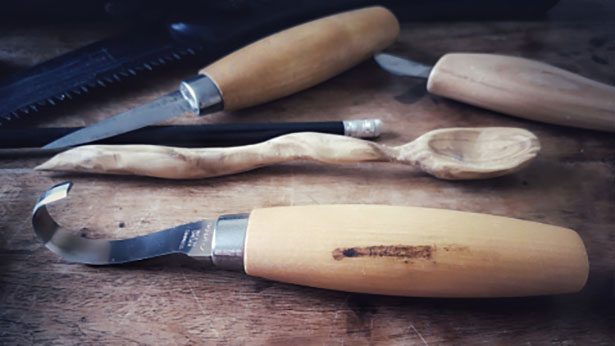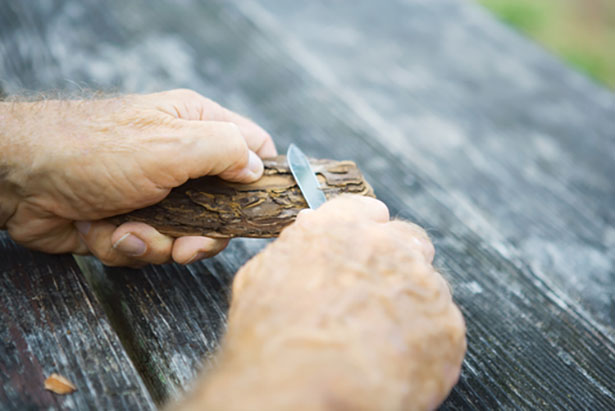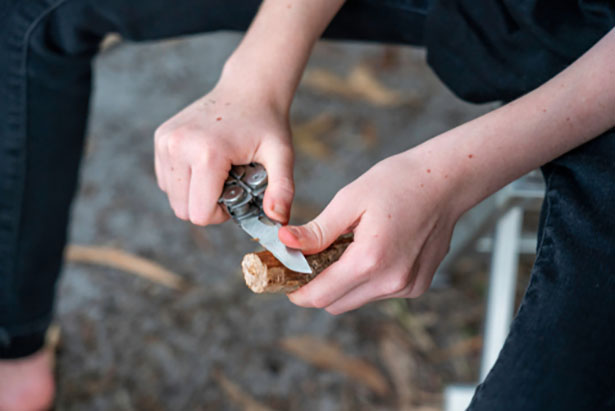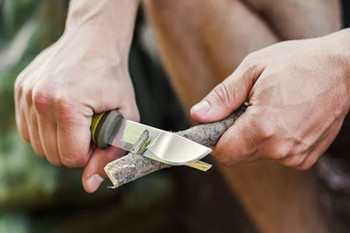How to Whittle: A Beginner’s Guide
Feb 7th 2019

Whittling is an age-old skill, but many today have forgotten the joys of learning how to carve objects from wood. With a little knowledge, patience and practice, you can safely use knives to enjoy this old form of craftsmanship.
Whether you want to carve your own cutlery or have something to keep your hands busy around a campfire, whittling enables you to develop hand-eye coordination and create something unique. It’s important to take your time and understand the building blocks of whittling skills to progress safely.
What You Need
You need a knife, some wood and a steady hand. Opt for soft woods, as these yield most easily to the knife and are the safest wood for beginners. Avoid wood with knots because they are tough to carve and choose pieces of wood with a grain that runs in one direction. The more unidirectional the grain of the wood, the easier it is to whittle.
Hardware or lumber stores are good places to find wood, especially for larger projects, and craft stores carry wood suitable for smaller-scale whittling endeavors.
Once you’ve mastered the basics, you can progress to harder wood.

Great Types of Wood for Beginners
Here are some of the best types of wood you can use for whittling as a beginner:
- Balsa
Lightweight and inexpensive, this soft wood is native to South America, Central America and Mexico. It’s inexpensive and perfect for your first projects.
- Basswood
The preferred wood of wood carvers, who aim to create intricate pieces, basswood is prized around the world. It doesn’t have much grain and is very soft.
- Pine
This traditional choice is soft and widely available—perhaps even in your own backyard. However, you may have to clear sap off a fresh pine stick before whittling, and some experts don’t think pine wood is the best for holding intricate detail.
- Branches and Twigs
As long as you’re conscious of local environmental issues and regulations, whittling from sticks, branches and twigs often makes for the most fun whittling. You might find the perfect stick in your backyard or a twig to whittle around the campfire on your next hunting or camping trip. Just make sure you’re not disturbing the local ecosystem.
Knife Options
You have several options for your whittling knife. Many traditional pocket knives have several blade sizes, giving you more control over each cut. However, you also must be careful of the hinged blade as you don’t want it to collapse on your fingers.
At eKnives, our team recommends an OTF, or out-the-front, knife. An OTF pocket knife has the advantage of an easily stowed blade but few of the drawbacks of a hinged blade.
Maneuverable and safe, this is an excellent option for beginning whittlers. Some states, counties and cities have laws limiting certain types of knives or even specific blade lengths. Check your state’s and city’s regulations on OTF knives.
Of course, regardless of whether you use your traditional folding pocket knife or an OTF knife, learn how to sharpen a pocket knife. This keeps your blade in good form, promotes the longevity of your knife and increases your whittling prowess. Most importantly, a sharp knife is a safe knife. Pair your knife with gloves for added safety, especially if you’re just starting out.
If you’re not a fan of gloves, at least use a thumb guard. This will protect your hands and your project as you learn how to safely hold and guide your knife.

Knife Strokes
While it’s best to learn knife strokes from a video or from an in-person whittling expert, here are some of the basic whittling strokes for you to practice:
- Straightaway Rough Cutting
This is the stroke you need to master first. Make long, smooth strokes away from your body to get the woodblock into the rough shape you need before you start doing more intricate work.
- Push Stroke
Also called thumb pushing, use your thumb to push the knife away from your body in short, smooth strokes. It’s a relatively safe way to get details in your project.
- Pare Cut
Often referred to as the pull stroke, this is the most common stroke in whittling. Brace your thumb against the block of wood and make short, controlled cuts toward your body—think of paring an apple. This stroke gives you the most control over the fine details of your carving—but take extra care, as you’re cutting toward your body. Use a thumb guard and keep your thumb out of the path of the knife.
Final Thoughts
Slowly carving wood away to reveal the form you’ve held in your mind’s eye is meditative and soothing. It exercises your mind, makes the most of your creativity and helps you pass time around the campfire. Step back into a simpler time with the craft of whittling.

